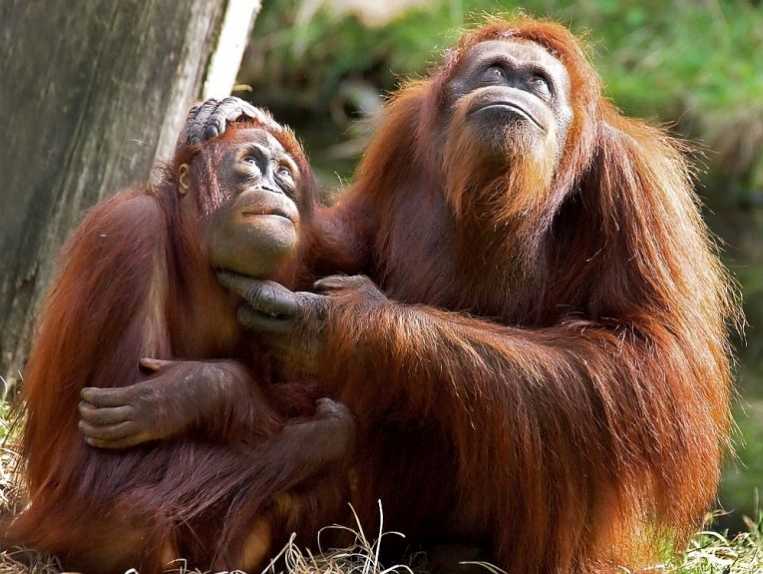Wildlife deserves better strategies for survival, habitat protection and breeding checks.
Orangutan image; Credit: © Shutterstock
Organisms taken from their native habitat and protected in sanctuaries or zoos can cause genetic headaches if they are mixed with others on any re-introduction. The case involved in this paper is the orangutan, previously regarded as one single species with one defined genome. With the publication of the Sumatran genome, we will soon know how inter-related the 2 species and the 3 varieties of the Borneo Pongo pygmaeus are.
Graham L. Banes, Birutà © M. F. Galdikas and Linda Vigilant of the Max Planck Institute for Evolutionary Anthropology and Simon Fraser University in BC, Canada, have studied the work of Camp Leakey in Borneo over 44 years. The orangutans there have frequently been non-native to the area and have produced many offspring who are basically hybrids of the 3 Borneo sub-species. These populations have been speciating independently for at least 80,000 years, following a spit in the 2 extant species about half a million years ago. A Vietnamese Pleistocene fossil for example gives some idea of the spread of the Pongo genus.
What does this mean for all of the animals (and plants) that we have been happily breeding for conservational reasons, with knowledge limited as their exact genetic affinities? Large endangered mammals, reptiles and amphibia. are now under intense human management. Rwanda has had a 4.1% increase in their Virunga Reserve’s habituated mountain gorillas. China sees more giant pandas produced by artificial insemination in anthropogenic nurseries than could be achieved by normal breeding. Zoos throng to pay for the privilege of buying them for exhibition. The question is where is the point of origin for this sperm and how can we avoid interfering with basically wild species, their natural immune responses and their genetic fitness.
Hybrid vigour could save some inbred communities, as with Texan cougars, transferred to the endangered Florida population and palpably doubling the genetic diversity (by reducing unwanted traits that affected genetic fitness) and hopefully their survival capability. Isolated wolf populations have also benefitted, so the picture is not all grey.
There is a downside to hybrids however. They can be infertile, as in the famed example of ligers and tigons. With differing habitats, varieties of a species demand alleles that fit them to their environment. The biggest problem is often hybrid swarms
whose success swamps the original population. This is feared to be the case with the big Scottish wildcat, Felis sylvestis sylvestriswhose interbreeding with domestics has almost eliminated the wild-type.
Among the great apes, who concern the paper particularly, 2650 are in sanctuaries, from 4 different species. Indonesia aims to rehabilitate orangutans quickly although the lack of habitat available will possibly affect the rate of progress. The current wild situation is that many reintroduced animals have brought various traits to the original populations in Kalimantan where Camp Leakey operates. Faecal sampling for this paper showed several generations had Borneo connections, most with the area of the Camp, but other mitochondrial DNA originated in NW Borneo.
The paper gives the notion that a cocktail of genes exits in this population around Camp Leakey, at least in 22 traced individuals. Males travel far to breed, given at least an area of 2500ha per adult. How much has the large natural population been affected, especially by the Sumatran genome? Hundreds of individuals were released in the 1980s and 1990s, both by government and Camp Leakey.
One positive result is that outbreeding depression seems to restrict the fertility of those orangutan that were released. This means the wild-type of any given area could revert back to an original state after a few generations. We can hope that further positive effect of natural hybridisation in neighbouring populations might enhance the survival of the 2 orangutan species. The lesson must be learned that dangers lurk among alien alleles introduced into a population. Sub-species are obviously important for survival in a shrinking world, as Indonesia has emphasised with well-established laws governing release.
The final plea of the authors is that as the genome of the Pongo pygmaea and its sub-species becomes known, the study of the detrimental effects of these hybridisations is accelerated s that we know how these species can cope with their legion of problems in the future. The paper is here in Scientific Reports.
To divert to Sumatra, here is the terrible story of the loss of habitat in Gunung Leuser National Park to paper and oil palm industries.










